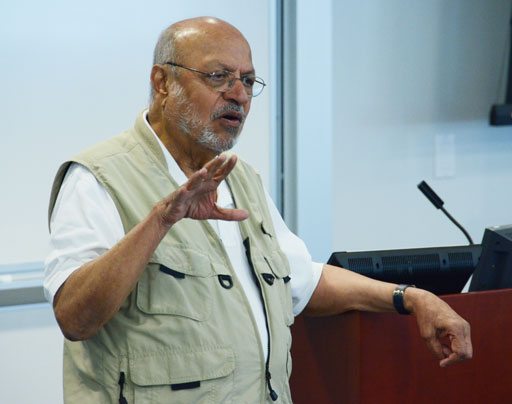The boundaries are blurring between different kinds of and genres of films.
WASHINGTON, DC: Director Shyam Benegal was in Washington earlier this year to attend the first annual South Asian Film Festival, where three of his movies — Mammo, Suraj Ka Satwa Ghoda and Sardari Begum — were screened. The Dadasaheb Phalke Award winner spoke to Global India Newswire. Here are excerpts:

Q: Do you think Indian films are becoming more popular in the United States and other Western countries?
A: It is very difficult to say because I don’t know. I do know that more money is being earned by Indian films in the U.S. today than ever before. That is already happening. And then there are people like Shahrukh Khan [whose] films do much better than the films of some of the other Indian heroes. But the fact is it has gained acceptance to a large extent. You can only tell when we are actually competing with the local products, how well we do in that competition. We haven’t come to that stage.
Q: Speaking of products, in India we have two different types of products, maybe three, if you count the “middle cinema.” We know that you don’t like the terminology…
A: That terminology, in fact, is now obsolete. There is no such terminology because [the different categories of films] could … converge. Film primarily has to be entertaining. But it is a question of what level and what kind of entertaining, what kind of entertainment and what kind of engagement that you want the audiences to have. That has to do with the way films are actually made. Now this generation of filmmakers, young generation of filmmakers today are making extremely wonderful pictures. Nobody is saying, ‘Oh, these are art movies,’ or anything like that. They are films that are engaging audiences, subjects that are also very serious [and] intelligent. They are not mindless films. Yes, you continue to have mindless films as well, along with very mindful films. But the number of mindful films that are being made today are much more than there ever used to be in the past.
Q: You are saying the boundaries between these different genres of films are blurring?
The boundaries are blurring between different kinds of and genres of films, which is a wonderful thing as far as Indian cinema is concerned.
Q: You don’t like the term “parallel cinema.” Some critics say that what they call as “parallel cinema” is dying. Do you agree?
A: First of all that name is rather unfortunate. I would call it alternate cinema, alternate form of entertainment. There is no such thing that it has died. How could it have died? It has only extended itself. It hasn’t died. And the so-called parallels have actually converged. There is no parallel cinema. There is good cinema, there is bad cinema, there is indifferent cinema. And that is how it should be.
Q: Hindi, Tamil and Telugu movies are making more money from overseas. With the globalization of Indian film market and influx of more money into the industry, have you seen any improvement in the quality of filmmaking?
A: In terms of technological use, yes. In terms of technology and in terms of the finish, today’s Indian films are very smartly made, much more smartly made than they used to. They don’t look rough at the edges, as they used to in the past. The same state-of-the-art technologies that are being used elsewhere in the world are being used in Indian cinema as well. So the question does not arise. Ultimately, it is a question of what kind of quality of films, in terms of content, in terms of narratives, in terms of performance qualities, in terms altogether of the story itself. What is it that you wish to tell, whether that has any weight, or it doesn’t, whether it is just powder puff? We make all kinds of films, and the quality of films in terms of content is also getting better overall. I don’t mean that all films are like that. But like every film industry everywhere in the world, there will always be films that are seen as money spinners, those that are seen as thoughtful, intelligent films and those that are seen as very intellectual ones. So we have all these kind of films even in India. Our cinema can be compared to any cinema in the world. Since we are the largest filmmakers in the world, and only the U.S. comes close second, we compare ourselves largely with American cinema for the same reason. Because the universally accepted cinema is U.S. cinema, and in our country, universally accepted cinema is our own cinema.
Q: You have unearthed a lot of gems and launched careers of a lot of actors. How would you compare today’s actors with them?
A: Excellent. You look at some of today’s actors, they are absolutely first-rate. There is never any problem in terms of the quality of performance. In fact, because we have such a large cadre of wonderful actors, we are never short of good actors, as far as India is concerned. We produced them by the bushels full. There is never any problem. Today, it is very difficult to look at a film and say, ‘This film has a very poor acting.’ It doesn’t happen anymore.
Q: Any films in the pipeline?
A: Oh yes, definitely. But I would rather not talk about what has not yet fructified.



